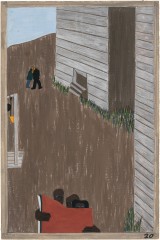The most widely read publications of the black press—weeklies such as the Chicago Defender and Harlem’s New York Amsterdam News and New York-based journals the Crisis, the Messenger, and Opportunity—encouraged southerners to seek better fortunes in the North. They reported unsparingly on lynchings, labor exploitation, and other injustices in the South while providing idealized images of the education, leisure activities, and cultural life in northern cities, as well as abundant job advertisements. Copies of these publications circulated widely in southern states during the Migration. Between 1916 and the early 1920s, the circulation of the Defender skyrocketed from about 33,000 to upward of 200,000. The number of copies sold, however, amounted to only a fraction of the readership of the Defender and other black publications, as copies were often passed from hand to hand or read aloud at homes, churches, and social gatherings.
The Defender was founded in 1905 by Robert Sengstacke Abbott, the son of former slaves, and became the most widely circulated black newspaper in the country. Its principal founding goal was the abolition of American racial prejudice. The periodical, still in print today, was a key force in the Great Migration, offering job listings and train schedules alongside fiery editorials and powerful political cartoons. African-American railroad porters, who would eventually organize as the Brotherhood of Sleeping Car Porters, were crucial in getting the Defender to the South, where white distributors and the Ku Klux Klan often attempted to block its circulation.



